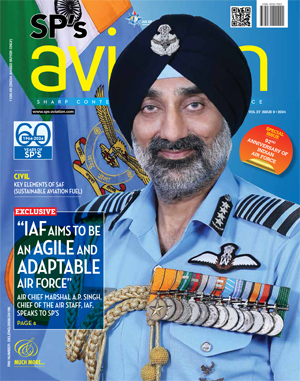INDIAN ARMED FORCES CHIEFS ON OUR RELENTLESS AND FOCUSED PUBLISHING EFFORTS

SP Guide Publications puts forth a well compiled articulation of issues, pursuits and accomplishments of the Indian Army, over the years

"Over the past 60 years, the growth of SP Guide Publications has mirrored the rising stature of Indian Navy. Its well-researched and informative magazines on Defence and Aerospace sector have served to shape an educated opinion of our military personnel, policy makers and the public alike. I wish SP's Publication team continued success, fair winds and following seas in all future endeavour!"

Since, its inception in 1964, SP Guide Publications has consistently demonstrated commitment to high-quality journalism in the aerospace and defence sectors, earning a well-deserved reputation as Asia's largest media house in this domain. I wish SP Guide Publications continued success in its pursuit of excellence.
Dutch Kindelberger (1895-1962)
After the War, Dutch Kindelberger turned to aircraft design. In 1925, he joined the Douglas Aircraft Company and within three years, became Vice President of Engineering

In 1940, with World War II in full swing, the British approached North American Aviation (NAA) for some urgently needed fighter aircraft for the Royal Air Force (RAF). NAA President James Kindelberger offered to make them a new design. The British agreed on condition it would be ready in four months. Kindelberger’s team went to work and built the revolutionary P-51 Mustang (minus the engine) in just 117 days. The aircraft was an immediate success, outperforming even the legendary Spitfire. It went on to become the most successful piston-engine fighter in history with over 42,000 aircraft built.
James “Dutch” Kindelberger was born on May 8, 1895, in Wheeling, West Virginia. His lifelong nickname referred to his descent from German (Deutsch) immigrants. And he certainly imbibed the German values of honest hard work, orderliness and punctuality. He was also a go-getter and an extrovert. At age 16, he dropped out of high school and took up a job as a steel mill apprentice, but soon realised the work was not for him. So he did a two-year correspondence course and joined the US Army as a civilian draftsman. When he witnessed a spectacular air show in 1913, he was hit by aviation fever. However, it was not until 1917 that he entered the Aviation Section of the Signal Corps. During World War I, he served as a pilot instructor.
After the War, Dutch Kindelberger turned to aircraft design. In 1925, he joined the Douglas Aircraft Company and within three years, became Vice President of Engineering. This was one of his most creative periods and he designed scores of aircraft for military and civilian use. The most noteworthy was the Douglas DC-3, a propeller-driven airliner, which revolutionised air transport in the 1930s and 1940s. More than 16,000 DC-3s were built for military and civilian users, including the Indian Air Force (IAF) till 1987.
Douglas was also where Kindelberger formed a lifelong association with JL “Lee” Atwood. The two spotted an emerging winner in NAA and joined the company in 1934, with Kindelberger being named as President and General Manager and Atwood as Chief Engineer. Over the next 30 years, they turned NAA (now part of Boeing) into the most successful aircraft company of the mid-20th century. NAA built more military aircraft than any other manufacturer in American history. Among the more notable aircraft developed under Kindelberger’s direction were the B-25 Mitchell II, the T-6G Texan and the P-51 Mustang.
The B-25 Mitchell II, a twin-engine medium bomber, was the first bomber used in all World War II combat theatres. It became famous in the Doolittle Raid. On the April 18, 1942, four months after the bombing of Pearl Harbour, 16 B-25Bs led by Lieutenant Colonel Jimmy Doolittle, struck Japan, driving home to the Japanese the vulnerability of their homeland to aerial attack. The T-6G Texan, a single-engine aircraft (called Harvard by the RAF), was the most famous Allied trainer of the war. Over 15,000 were built and it became one of the most widely-used trainers ever, operated by many of the world’s air forces, including the IAF, till 1975.
Strangely enough, the P-51 Mustang was originally ignored by the Americans. It wasn’t until 1942 that the USAAF ordered 310 P-51As and 300 ground attack/bomber A-36A Mustangs. Much later the sordid reason for the delay emerged – Dutch Kindelberger had refused to pay the kickbacks requested by some officials in return for the lucrative contract. Once the Mustang’s potential was realised, the Americans strove to make up for lost time. And with 14,819 Mustangs of all variants built for the US Air Force (USAF), the Mustang eventually sealed American aerial dominance in the War. The most popular P-51D, of which almost 8,000 were produced, was powered by a single Rolls-Royce V-1650 Merlin engine that gave it a top speed of 708 kmph at 25,000 ft. It carried six .50 calibre machine guns with a total of 1,880 rounds.
After the war, military aircraft manufacturers worldwide saw their order books decimated and North American was no exception. But under Kindelberger’s guidance, it emerged from the doldrums fairly soon. NAA played a major role in the emerging US Space Programme, even as it continued to build new fighters such as the F-86 Sabre and the F-100 Super Sabre.
Dutch Kindelberger retired from North American Aviation in 1960 and died on July 27, 1962, in California. Lee Atwood who took over as NAA’s Chief Executive said of him: “From the first moment that I met Dutch, I knew that he was destined for even greater things in aviation. We who worked with Dutch learned to have high regard for his quickness in detecting important, though minute, details that always seemed to be the determining factor between success and failure. When you are in the air – that is all important!”





